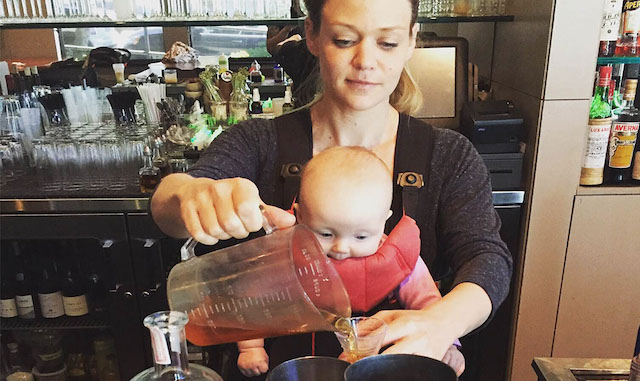Pictured above: Kate Bolton and her daughter, Sage Olivia.
Alexis Le worked behind the bar in New Orleans until seven days before she delivered her first baby, Salvador, in 2008. Near the end of her pregnancy, Le couldn’t change kegs or lift certain items, but for the most part, her job didn’t change and the pregnancy was uncomplicated. She received flexibility in her schedule about returning to work and generally had a positive experience. “One of my managers said, ‘Who wants a big, pregnant bartender?’ and that got on my nerves a little,” she said. “But I was 27 and in my six years of bartending, I worked with a handful of pregnant bartenders who went through the same thing.”
Le had a harder time during her second pregnancy in 2012. When the company began planning to open a new restaurant, Le hoped to follow her favorite manager. “I was told I couldn’t help open a new place because I was pregnant,” she said. “They said it was too much work for a pregnant person and that I couldn’t handle it. I felt like I was mommy-tracked after that.”
Once Rosalia was born, Le struggled to find reliable child care and cover shifts when her children were sick. At one point, her daughter had a long-term illness and lost 20 percent of her bodyweight, dropping to 25 pounds. “I remember one of the managers giving me attitude over the phone, and I replied back that I was the only person who could do what I was doing right then,” she said. “I was sitting in the children’s hospital with my daughter.”
Like many moms behind the bar, Le received a small amount of paid time off based on Louisiana’s $2.25 per hour base pay. However, she’s struggled to find adequate child care, cover shifts or provide health insurance for her children. Without her husband’s help, Le wonders how she would have been able to pay the bills. “I see the industry as a boys’ club still,” she said. “I don’t have a lot of hope for changes [for moms] because of that.”
 Lauren Myerscough bartended full-time when she was pregnant with her daughter Ada. Complications from the pregnancy (and the lack of a sufficient maternity leave policy in place) forced her to resign in the beginning of her third trimester.
Lauren Myerscough bartended full-time when she was pregnant with her daughter Ada. Complications from the pregnancy (and the lack of a sufficient maternity leave policy in place) forced her to resign in the beginning of her third trimester.
Working when pregnant
Lauren Myerscough worked full-time behind the bar when she was pregnant with her daughter Ada, who is now 9 months old. She tried to hide that she was pregnant through the first trimester, though it was difficult when she couldn’t drink alcohol. “You can only tell people you’re on antibiotics for so long,” she said with a laugh. “Plus, it’s difficult to work when the smell of food is nauseating and you want to run away and vomit.”
During her pregnancy, Myerscough developed hormonal tachycardia, or an irregular heartbeat, which sometimes skipped a beat during shifts. By seven months, she hadn’t gained enough weight and decided to resign. She didn’t qualify for Family and Medical Leave Act benefits because the company had fewer than 50 employees, and an emergency C-section required her to rest longer than the suggested minimum six-week recovery time. “My employer wasn’t keen about letting me have that much time off,” she said. “If I hadn’t had some money in the bank, we would have been in trouble. There was no other net in place.”
When she left, Myerscough and husband Max Messier decided to create their own company, Cocktail & Sons, to sell handcrafted syrups. The couple launched a Kickstarter campaign that pulled in $10,000 and started their business in January 2015. Although a new business has been stressful to manage, they’re thrilled they can stay at home with Ada while they work. “When I was pregnant, we realized how turbulent jobs in the service industry are,” she said. “We needed something more grounded. Daycares don’t stay open until 2 a.m.”
Still working alongside the industry, Myerscough hopes to see changes in the future that support families behind the bar, particularly with child care and family leave options for both fathers and mothers. “We need to understand that it takes time to recover,” she said. “I can’t imagine only having six weeks and then walking away and handing over my child. I don’t think I could have done it.”
Returning to work
When Star Hodgson gave birth to her first son in 2006, she didn’t know about short-term disability options or how her management pay would change. She planned to take three months off but was asked to come back halfway through her leave to attend meetings or train new staff. The first day she went back to work, Hodgson brought her son along while she prepared for an event. During bar shifts, she often nursed or pumped in the basement bathroom when she could escape during a slow moment. “Knowing what I know now, that was in violation of family rights,” she said. “It was a lot of the same with my second son in 2009, only I was better at finding time to pump.”
Hodgson recalls a time when she was nursing her second son in the back of the restaurant with a cover over his head. She received a text from her boss saying that she couldn’t nurse in public — and she responded that she could. “He wasn’t even there,” she said. “Somebody had called or texted him to complain.”
Now that Hodgson is a brand ambassador rather than behind the bar, she’s able to observe other venues and speak with women about their experiences. She hopes that employers will consider setting up office space for nursing, pumping and resting during shifts. This office space could also post signs about reproductive health. “We see hand washing and occupational safety signs posted, so family rights should be as well,” she said. “It’s getting better, but women are still uninformed and taken advantage of as employees when it comes to childbirth and child raising.”
 Jacquelyn Zykan tended bar until she was six months pregnant. Her bosses then instituted a leave plan modeled after the one at Brown-Forman Corporation, which included six weeks of paid leave and six weeks of unpaid leave, and an adjustment to her salary (to compensate for a lack of tips).
Jacquelyn Zykan tended bar until she was six months pregnant. Her bosses then instituted a leave plan modeled after the one at Brown-Forman Corporation, which included six weeks of paid leave and six weeks of unpaid leave, and an adjustment to her salary (to compensate for a lack of tips).
Finding adequate options
Kate Bolton (pictured in the top photo), partner at a bar and restaurant in San Francisco, worked out a plan with her business partner when she found out she was pregnant. She agreed to work five shifts per week as long as she felt comfortable and then transition to administrative work such as hiring, training, ordering, receiving and menu development. Around four months, she stopped working the closing shift, which allowed her to go home and sleep at a reasonable time. She also started taking five-minute breaks to put up her feet in the office. Toward the end of her pregnancy, Bolton switched wells because her usual spot was shorter and the tops of the liquor spouts poked her stomach. “It was important to me that I show my bar team and co-managers that I was tough and had a strong work ethic and that having a baby wasn’t going to change me,” she said. “I mistakenly thought that having a huge pregnant belly was just going to be like being really fat, like having a beer belly. Boy, was I wrong.”
Around six months, it was tough for Bolton to keep working, and by eight months, she had a health scare that prompted her to stop working shifts. She delivered three weeks early and took about three months off bar shifts but maintained her managerial and creative duties. “It was the first baby to be born since we opened [the restaurant] together, so it felt like [the restaurant] was having a baby,” she said. “Everyone was really involved and excited, and it feels like my daughter has this whole extended restaurant family. I love it.”
Bolton resumed her managerial duties 10 days after delivery, and when she returned to count inventory, place orders or develop cocktails, she brought along Sage Olivia, who is now 10 months old. “She was just part of the deal,” Bolton said. “I really tried to make strides in showing our industry that having a baby — and having a baby be a part of the equation — is possible.”
Similarly, Jacquelyn Zykan made a leave arrangement at the bar she worked at in Louisville, Kentucky, and stayed behind the bar until she was six months pregnant and her feet hurt. When Zykan approached her bosses at eight weeks into the pregnancy, they realized the company had never had a pregnant upper management employee. They put together a leave plan modeled after the one at Brown-Forman Corporation, which included six weeks of paid leave and six weeks of unpaid leave. Zykan added two weeks of vacation leave on top of that. Since Zykan would no longer earn tips, the group also adjusted her salary to compensate. “That definitely helped when planning the financial change that comes with a new baby,” she said. “For the first time, I had 100 percent consistent income.”
Zykan’s beverage director position transitioned to daytime hours, and she did the majority of her work on a laptop in the office or from home so she could stay off her feet. She was also able to stay at home longer to breastfeed and save on daycare costs. Though it may not be possible for every employer to offer paid leave, Zykan suggests flexibility for work responsibilities, breaks for physical strain during pregnancy and breaks for pumping after delivery.
“Keep in mind that it’s a completely different experience for each person. Some people get tired, some get sick, some get sore, some gain weight and some get moody,” she said. “It’s temporary, and at the end of it all, the more supportive you are as an employer, the more loyal your employee will be upon return.”





